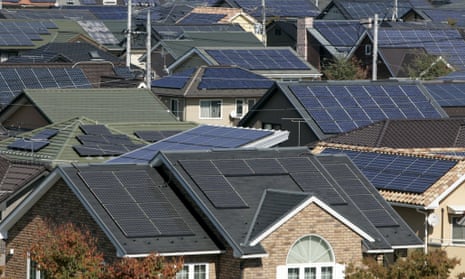Japan is proposing to cut its greenhouse gas emissions by 26% by 2030 as its contribution to a global summit on climate change in Paris later in the year.
Media reports earlier this month said the country was looking at a 25% percent cut from 2013 levels, up from an earlier target of about 20%.
Japan, the world’s fifth biggest emitter of climate-warming carbon dioxide, has previously watered down emissions targets as the shutdown of its nuclear plants after the 2011 Fukushima disaster forced its utilities to burn record amounts of gas and coal to generate power.
The country’s latest proposal, issued by the industry and environment ministries on Thursday, includes a target to reduce emissions by 25.4% by 2030 from 2005 levels.
But government officials said they would prefer to use 2013 as a baseline, which implies a higher reduction target than other major developed countries.
The European Union has said it is looking to cut emissions by at least 40% from 1990 levels by 2030, while the United States is proposing a 26 to 28% cut from 2005 levels by 2025. From 1990 levels, Japan’s target would represent a mere 18% cut.
“It’s not fair to pick 2013 as baseline since it would ignore all those efforts made by other countries to cut emissions since 1990,” said Kumiko Hirata, coordinator of environmental group Climate Action Network Japan.
“Japan is trying to make its target look bigger by selecting 2013 as a base, when the country emitted so much greenhouse gas,” she said.
Japan’s greenhouse-gas emissions rose to 1.41bn metric tonnes of carbon dioxide equivalent (CO2e), the second-highest on record, in the year ending March 2014, reflecting a rise in coal-fired power after the indefinite closure of nuclear power plants. That was up 10.8% from 1990.
Hirata said Japan will be blamed by global communities not only for a low target, but also for a series of plans by Japanese companies to build coal-fired plants at home.
Japan’s target for emission cuts is based on a proposed new power generation mix for 2030, unveiled by the industry ministry on Tuesday.
The government wants to make nuclear energy account for 20 to 22% of Japan’s electricity mix, versus 30% before Fukushima, with renewable energy making up 22-24%, liquefied natural gas for 27% and coal 26%.
“Japan should set a higher emissions cut target as renewable energy ... can make up bigger portion,” Yukari Takamura, professor at Graduate School of Environmental Studies at Nagoya University, said.
The Ministry of Economy, Trade and Industry and the Ministry of Environment have been holding joint panel meetings on the emissions target since last October.
Japan is looking to finalise the plan as soon as possible and announce its carbon emissions targets at the G7 meeting in Germany in early June.
The Paris summit starting in November aims to finalise an agreement as part of efforts to limit global average temperature rises to 2C above pre-industrial times.
Separately, a new UN fund intended to help developing nations tackle global warming said the United States and Japan will miss a Thursday deadline to provide billions of dollars to help poorer countries deal with climate change.
The Green Climate Fund (GCF), which wants to decide on a first set of projects to aid developing nations before the Paris summit, said donors had signed deals of almost $4bn, 42% of a total promised in November 2014.
The signed deals, which lay out a firm timetable for when promised money will be paid, are below the minimum level set by donors, of 50% of the total by 30 April, to start full operations by the GCF.
“A lot of progress has been made,” Hela Cheikhrouhou, executive director of the Fund, told an online news conference from South Korea on Thursday.
“The work is not finished,” she said, urging governments to speed up contributions to help get on track.
Top donors the United States, which promised $3bn, and Japan, on $1.5bn, were not among nations that have signed deals, according to a GCF overview. Cheikhrouhou said no new deals were expected later on Thursday.
Britain and Germany led by signing deals covering their full amounts of $1.2bn and $1bn respectively, followed by Sweden, France, Norway and the Netherlands.
The fund is intended to help developing nations cut their greenhouse gas emissions by shifting to renewable energies such as solar or wind and help them adapt to changes such as more floods, desertification and rising ocean levels.
It has not ruled out funding fossil fuels, if they help towards cleaner energy use.
The fund raised $9.35 billion at a pledging conference in November but new cash promised since then, including by Australia, has raised the pledged total to $10.2bn.
Separately, Cheikhrouhou told Reuters that the fund was “an essential ingredient of a successful agreement” in Paris.
The GCF is meant as one of the main avenues of a 2009 deal to mobilise $100bn a year in aid to developing nations, from public and private sources, to help combat climate change.
Cheikhrouhou said emerging economies needed to invest about $2.5tn a year in sectors such as energy, transport, agriculture and industry and an extra $450bn to ensure they were green.

Comments (…)
Sign in or create your Guardian account to join the discussion